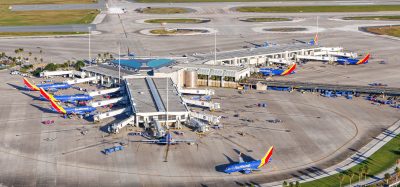Denver International Airport: Improving the passenger experience through transformational projects
Posted: 20 August 2025 | Phillip A. Washington | No comments yet
CEO of Denver International Airport, Phillip A. Washington, writes exclusively for International Airport Review about enhancing efficiency with high-tech security lanes and preparing for 100 million annual passengers through terminal upgrades.


Credit: Denver International Airport
At Denver International Airport (DEN), we strive to meet and exceed the needs and desires of our customers. Enhancing our customers’ experience is a guiding principle of our Vision 100 strategic plan to prepare DEN for 100 million annual passengers, a milestone we anticipate hitting in the coming years. We meticulously study each aspect of the customer journey, from their commute to the airport, to boarding their flight, and every possible step they may take in between.
In addition to our internal efforts to capture the customer voice by consolidating data from social media engagements and customer service interactions, we rely on the Airports Council International Airport Service Quality (ASQ) quarterly survey for customer satisfaction to understand where we need to make improvements. Our team works diligently to communicate the issues they discover with leadership and the appropriate divisions. Teams then work together on determining solutions. Some are quick wins like signage enhancements, while others are longer term projects like the addition of play areas, enhanced security screening and the remodelling of concourse and restrooms.
The screening process begins with Credential Authentication Technology (CAT) II at every lane to verify passenger identity and quickly access your boarding pass using digital or traditional identification and facial recognition.
Recently, ASQ survey results pointed to a significant increase in satisfaction for the “ease of going through security screening” category as well as for the “waiting time: security screening” category. In both areas we saw double-digit score increases within a six-month period. What this ASQ data showed is that DEN’s Great Hall Project is already improving the overall experience of our airport.
Join our free webinar: Revolutionising India’s travel experience through the Digi Yatra biometric programme.
Air travel is booming, and airports worldwide need to move passengers faster and more efficiently. Join the Digi Yatra Foundation and IDEMIA to discover how this groundbreaking initiative has already enabled over 60 million seamless domestic journeys using biometric identity management.
Date: 16 Dec | Time: 09:00 GMT
rEGISTER NOW TO SECURE YOUR SPOT
Can’t attend live? No worries – register to receive the recording post-event.


Jeppesen Terminal tents at sunset at DEN. Credit: Denver International Airport
The Great Hall Program is a multi-year $2.1 billion capital improvement programme that is helping us prepare for the future by enhancing safety and security, improving operational efficiency and increasing capacity of DEN’s Jeppesen Terminal. In addition to upgrades and renovations to the entire facility, the cornerstone of the project is new state-of-the-art security checkpoints that improve safety, increase screening capacity and make the process more efficient for travellers. It’s rare to have an opportunity to reconstruct a major airport terminal, to modernise and reimagine it for the needs of today’s travellers as well as the travellers of tomorrow. With the Great Hall Program, however, we are doing just that. I am also pleased to report that during my tenure as CEO, we have reached project milestones on time and under budget while minimising passenger impact, despite increasing passenger volumes.
Improving security screening through cutting-edge technology
After DEN’s new West Security Checkpoint opened in early 2024, we quickly saw a return on our investment. Opening this checkpoint was an important milestone for the airport, in terms of ensuring that we’re meeting increasing passenger demand and doing so in a safer, more efficient way using state-of-the-art technology. The screening process begins with Credential Authentication Technology (CAT) II at every lane to verify passenger identity and quickly access your boarding pass using digital or traditional identification and facial recognition. Next, the Daifuku/Scarabee Automated Screening Lanes allow passengers to leave items like liquids and laptops in their bags; allow multiple passengers to place their items in bins simultaneously to help expedite the process; features automatic bin returns to the front of the line; and are coupled with Smiths Detection 3D X-ray technology that captures images of the contents of each bin. These images are viewed from a remote screening location, further minimising distractions and allowing officers to focus on security. Bins or items that require additional screening are automatically redirected by the security lane to a secondary screening area. There, officers can use Radio Frequency Identification (RFID) tags to pull up the images of the bin.
This capital investment in our infrastructure is already fulfilling the vision of the project and exceeding our customers’ expectations.
Though the number of lanes in this new checkpoint is fewer than the legacy checkpoint we closed, we have increased the overall capacity of our screening operations across the board. At the West Security Checkpoint, the average wait times are less than four minutes, in contrast to around 14 minutes at our remaining legacy checkpoint. Additionally, because of the throughput efficiencies created in each lane of this checkpoint, we now direct more than 55% of our passengers to be screened at this location. This checkpoint – its design and operation – is a testament to how we collaborate with our partners at the Transportation Security Administration (TSA) to balance security innovation and federal compliance.
The East Checkpoint, which will be a mirror image of the West Checkpoint, opens in August 2025 (at which point the remaining legacy checkpoint will close). The Completion Phase of the Great Hall program, which is now underway, will finalise the full build-out of the Jeppesen Terminal, bringing it up to speed for future growth, critical infrastructure needs and desired passenger amenities. By the end of 2027, when Great Hall construction will be complete, the experience of going through security, meeting loved ones, and enjoying the Jeppeson Terminal’s art, dining and retail options, will be transformative.
There’s always room for improvement when it comes to the customer experience of any large-hub airport, and we know we won’t always get it right. But, it is encouraging to see preliminary customer feedback indicate we are headed in the right direction in making their experience at our airport more efficient and enjoyable. We have a little more than two years of construction ahead of us, which will come with its own frustrations and challenges, but this capital investment in our infrastructure is already fulfilling the vision of the project and exceeding our customers’ expectations.
About the author
Phillip A. Washington is CEO of Denver International Airport, the third busiest airport in North America by passenger traffic. He oversees more than a nearly $12 billion dollar Capital Improvement Program to modernise the airport to accommodate 100+ million annual passengers.
WATCH NOW ON DEMAND: Enabling checkpoint flexibility with responsible open architecture
Join us for an essential virtual panel supported by Smiths Detection. We will explore how airports can overcome the challenge of mixed vendor systems by adopting a flexible, open approach to checkpoint technology.
This session offers a focused look into achieving efficiency, agility, and future-readiness.
Key learning points
- Understand what to ask during procurement to ensure long-term flexibility and avoid vendor lock-in.
- Learn how centralised image review and flexible algorithm use can help you get more from the technology you already own.
- Strategies to make mixed vendor screening systems work together to improve checkpoint performance and reduce costs.
- See examples of collaborative deployments and the operational agility they enabled.
Register now for expert insights from Los Angeles World Airports, Dutch Ministry of Justice and Security, and Smiths Detection!
Related topics
Airport construction and design, Artificial intelligence (AI), Digital transformation, Funding and finance, Innovation, Operational efficiency, Passenger experience and seamless travel, Security, Terminal operations, Workforce
Related airports
Related organisations
Airports Council International (ACI), Smiths Detection, Transportation Security Administration (TSA)


















